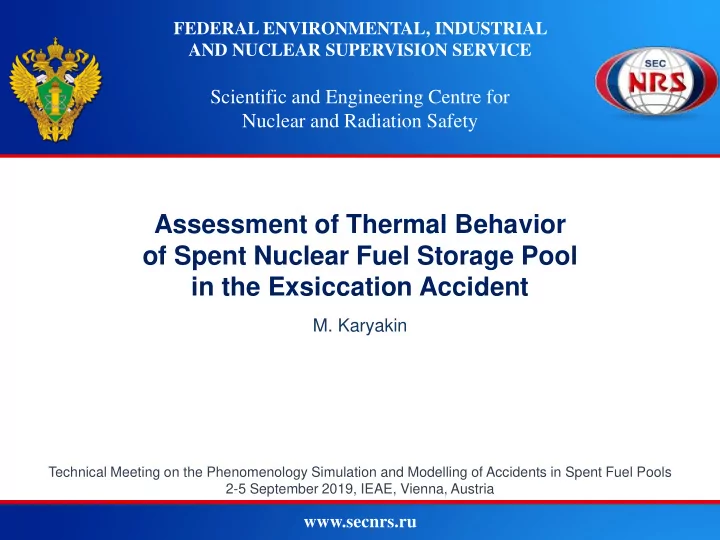

FEDERAL ENVIRONMENTAL, INDUSTRIAL AND NUCLEAR SUPERVISION SERVICE Scientific and Engineering Centre for Nuclear and Radiation Safety Assessment of Thermal Behavior of Spent Nuclear Fuel Storage Pool in the Exsiccation Accident M. Karyakin Technical Meeting on the Phenomenology Simulation and Modelling of Accidents in Spent Fuel Pools 2-5 September 2019, IEAE, Vienna, Austria www.secnrs.ru
Outline I. Introduction II. Scenario 1: Compartment of SNF storage facility III. Scenario 2: Uncompensated leakage IV. Conclusion www.secnrs.ru 2
Introduction ➢ The accident at the Japanese nuclear power plant (NPP) Fukushima-1 in March 2011 showed that possibility of accidents with potentially serious radiation consequences couldn ’ t be excluded with large-scale measures for improvement of safety level ➢ In the presentation is given the description of the assumptions and approximations used by SEC NRS to create computational models of wet SNF storage for representative scenarios of occurrence of accidents involving loss of decay heat removal from the SNF www.secnrs.ru 3
Scenario 1: Compartment of SNF storage facility www.secnrs.ru 4
Scenario 1: Storage racks scheme Principal scheme Computational zones www.secnrs.ru 5
Scenario 1: APROS capabilities ➢ determine the thermal-hydraulic characteristics of systems by solving the equations of heat and mass transfer in steam-water mixture ➢ modelling static and transient operating conditions and emergency scenarios ➢ real time simulations ➢ modelling NPP with different design (VVER, RBMK, PWR, BWR, CANDU, HTGR, etc.) ➢ three-dimensional nodal methods www.secnrs.ru 6
Scenario 1: Computational model of storage compartment, implemented with Apros www.secnrs.ru 7
Scenario 1: Time dependence of the flow rate 0.4 0.3 Flow rate, kg/s 0.2 0.1 0.0 -0.1 -0.2 -0.3 0 100 200 300 400 Time, h Time dependence of the air water vapor mixture flow rate in supply (blue) and exhaust (red) ventilation systems www.secnrs.ru 8
Scenario 1: Time dependences of the water level and temperature of the rack structures 8.0 900 800 7.0 700 6.0 Temperature, °С Water level, m 600 5.0 500 4.0 400 3.0 300 2.0 200 1.0 100 0.0 0 0 200 400 200 250 300 350 Time, h Time, h Time dependence of the water level Time dependence of the temperature in the storage compartment of the maximum stressed section of the fuel rod cladding (blue) and the covering tube (red) www.secnrs.ru 9
Scenario 1: Vertical distribution of the fuel rod temperature for different times 800 180 hours 230 hours 700 280 hours 330 hours Temperature, °С 600 500 400 300 200 100 0 0 1 2 3 4 Fuel rods height, m The temperature distribution in the cladding height for different development times of the accident www.secnrs.ru 10
Scenario 2: Uncompensated leak www.secnrs.ru 11
Scenario 2: ANSYS Fluent capabilities ➢ determine the thermal-hydraulic characteristics of systems by solving the equations of heat and mass transfer in steam-water mixture ➢ modelling static and transient operating conditions ➢ simulate multiphase flows ➢ simulate natural convection flow ➢ three-dimensional finite volume methods www.secnrs.ru 12
Scenario 2: Modelling of the fuel rods cladding heat-up using ANSYS Fluent 1200 1000 Temperature, °С 800 a 600 400 200 0 b 0 3 6 9 a b Time, d Computational model Temperature-time dependence of the fuel rods cladding heat-up www.secnrs.ru 13
Conclusion ✓ The presented qualitative analysis of the possibility of radiation consequences of the accident with the complete loss of power supply in the SNF storage indicates the need for a more detailed consideration of possible severe accidents at nuclear fuel cycle enterprises ✓ It is shown that for the early adoption of preventive measures for the organization of additional recharge emergency storage compartment at the initial stage of the accident, it is important to determine as accurately as possible the available time for their implementation ✓ The computational models are using in the safety assessments which are implemented at SEC NRS www.secnrs.ru 14
Recommend
More recommend